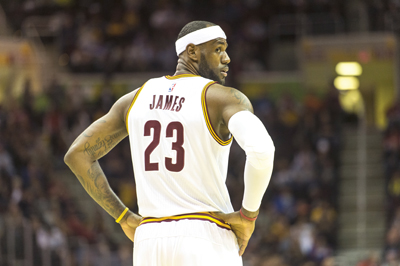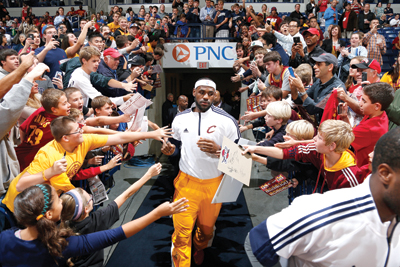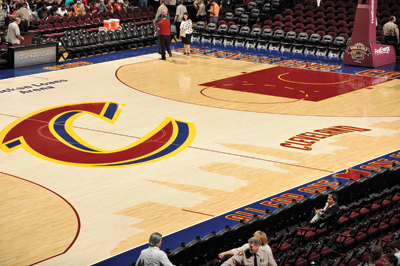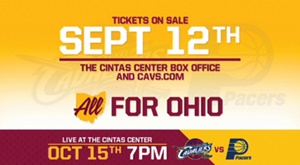Welcome to the new-look Cleveland Cavaliers — thanks in large part to a familiar face being back in town.
A summer that will be most widely remembered for LeBron James returning to his hometown team saw the Cavaliers reprogram their sales efforts, rebuild their sponsorship approach and double down on their desire to become a regional franchise. Those efforts all parallel a $23 million refresh of Quicken Loans Arena, an effort that will provide for a massive new scoreboard, new digital branding, a new playing floor, and a revamped in-game presentation.
Under orders from owner Dan Gilbert to avoid an obvious money grab with James’ return to Cleveland, the Cavaliers quickly capped season-ticket sales at 12,000 just hours after James announced his return in July. The team also opted not to raise ticket prices for the new season — even for the most expensive, courtside seats, which cost up to $1,000 a game. They have, however, created a lottery to make single-game tickets available to fans, keeping in mind Gilbert’s “numbers and money follow, they don’t lead” business mantra.
{podcast}
SBJ Podcast:
NBA writer John Lombardo and Assistant Managing Editor Tom Stinson discuss how the Cavs are handling LeBron James' return from a business perspective, as well as how the NBA's new breed of GM could change the game.
Cavs executives confirmed an increase in season-ticket sales but would not disclose the degree of the increase. Cleveland ranked 16th in the 30-team NBA last season with an average attendance of 17,330 fans per game.
But beyond the change in volume for ticket sales that the recent months have brought, this summer saw a change in sales strategy in Cleveland, for both tickets and for sponsorship sales. In this regard, James’ return served to dovetail with plans the Cavs were already making rather than spark the changes.
 |
LeBron James’ second chapter in Cleveland dovetails with moves the club was already planning.
Photo by: GETTY IMAGES
|
“Things were already in place,” said Kerry Bubolz, president of business operations for the Cavs. “Then LeBron made his decision, and we were prepared.”
The Cavs’ summer began by winning the NBA draft lottery, earning them the league’s top pick in the June draft. Cleveland used that pick to select Andrew Wiggins, and they followed that by re-signing all-star Kyrie Irving with a five-year, $90 million contract extension. Already, a team that finished last season with a 33-49 record had traction for better days ahead.
But then came James’ decision, and with the subsequent dealing of Wiggins to Minnesota to add all-star Kevin Love to the Cavs as well, a busy offseason turned into a full-on frenzy.
The Cavs kept their 50-member sales force intact during the offseason but reprogrammed it into a more service-focused group while also using the newfound Cavs demand to raise fan awareness around the Cavs-owned AHL Lake Erie Monsters, D-League Canton Charge and AFL Cleveland Gladiators.
“We had a shifting of business-development specialists into client-experience specialists,” said Cavs CEO Len Komoroski.
That shift required retraining within the sales group, a process that is still ongoing.
 |
Photo by: GETTY IMAGES
|
The Cavs also revamped their sponsorship department, adding four employees for a total staff of 18 and emphasizing more partner activation and integration.
“We retooled the entire sponsorship structure,” Bubolz said. “We now have nine folks just focusing on activation and up-selling, and nine focusing on driving new business across all assets.”
Team executives
 |
When LeBron James takes the court for the home opener, Quicken Loans Arena will sport a new floor, scoreboard and more.
Photo by: NBAE / GETTY IMAGES
|
acknowledged that the moves have brought a significant increase in the team’s sponsorship business, but Bubolz refused to discuss any specifics.
On the PR side, the organization reassigned to the Cavs a staffer who previously worked across all of the Gilbert-owned teams (Monsters, Charge and Gladiators) to help handle the crush of national media interest in the team now. The Cavs also added four staff members to their digital operations group as a result of a vastly increased digital audience for all-things-Cavaliers. The number of visits to Cavs.com in September was up nearly fivefold compared with last September, while video streams on the team site have increased nearly 20 times from the numbers seen last September.
All the enthusiasm extends into Cleveland’s arena as well, with Quicken Loans Arena slated to receive $23 million in upgrades over the next 10 months. While some of the arena enhancements draw less from the Cavs and more from the city’s successful bid to land the 2016 Republican National Convention — a decision that came the same week in July that James announced his return to Cleveland — the additions will serve to add more “wow” to the in-arena experience when the Cavs’ regular season tips off later this month.
Most notable in that regard is a new center-hung video board, the facility’s first in almost a decade. Produced in part by ANC Sports, the new board will fall in line with the new generation of monster boards at Bankers Life Fieldhouse, Toyota Center and the Palace of Auburn Hills, Komoroski said.
The Cavs said the board, covering 5,550 square feet of total LED space, ranks as the biggest in the NBA. The board is installed but it’s been under cover for Cleveland’s preseason games. It will be unveiled for the regular-season and home opener on Oct. 30, team officials said.
The Cavs have replaced the old tri-vision and LED displays in the arena’s four corners and the fascia in the seating bowl, as well. The same is true for new concourse LED signs replacing old backlit structures.
All told, the new video screens, plus a new control room and sound system, cost $15 million to $16 million, Komoroski said.
 |
The team rolled out regional ads and has preseason games in Cincinnati and Columbus.
|
The money, part of the overall arena improvement plan, was made available after voters in May approved an extension of a county tax tied to the sale of tobacco and alcohol products. The same tax helped pay arena construction debt.
Also for the arena, the Cavs this season will have a new, $150,000 playing floor, and they’re juicing their in-game presentation with the addition of a $1 million, 3-D court projection system that will be used for player introductions and during select timeouts. Both moves were approved prior to James’ signing in July, but his return served to justify the added expenditures.
The Cavs have teamed with YinzCam to develop a new mobile application for the arena, as well. This new offering, which will include multiple replay angles, debuts Oct. 27, and officials are in the market to find a sponsor for the feature, Bubolz said, but no deals had yet been signed.
The impact of James’ return to Ohio hasn’t been limited to Cleveland. With James back on their roster, the Cavs once again are looking to develop a regional fan base, an effort previously seen during James’ first years with the team (2003-10).
Cleveland this month is playing sold-out preseason games at two in-state college venues: Xavier’s Cintas Center and Ohio State’s Value City Arena. The team also has rolled out regional ads playing to markets outside of Cleveland. A Columbus-based ad, for example, features OSU football coach Urban Meyer, basketball coach Thad Motta and football legend Archie Griffin — with each saying “I’m a Cavalier” and a closing tag on the ad of “All for Ohio.”
The team is even looking to make inroads into Pittsburgh, a two-hour drive southeast of Cleveland.
“We have customers in those markets,” Bubolz said, “and we are finding ways to distribute our games and build our fan base.”







